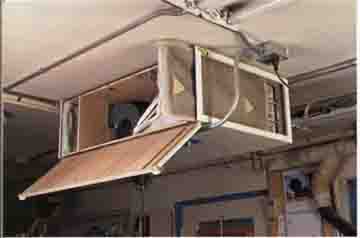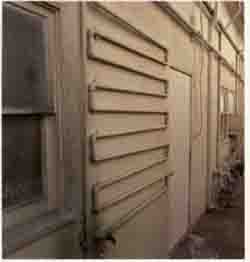AMAZON multi-meters discounts AMAZON oscilloscope discounts
The compressor is the heart of any shop’s air system. It is the pump that presses the air molecules together and traps them inside a storage container so that their stored energy can be used to do the work you need to do. Compressors come in a befuddling assortment of sizes and types, which makes choosing one all the more daunting. The motor that drives the pump on most woodshop compressors is electric, but gasoline-engine-driven compressors are also available if your shop is in the boonies, beyond where the power poles end.
The importance of compressor size
The basic rule when it comes to choosing a compressor is “bigger is better.” We have yet to hear a woodworker complain about his compressor being too big, but if yours is inadequate in size, it’ll make your life miserable.

Although it’s no substitute for a central dust-collection
system, an air- filtration device can remove fine dust from the air without
exhausting the air outdoors. This shop-made device consists of a ply
wood cabinet with a motorized fan and filters mounted inside.

Connecting a portable air tank downstream from
a 1-hp or 2-hp compressor can temporarily boost its air capacity and increase
the amount of time you can work with air- hungry devices, such as this pneumatic
die grinder, before the compressor must recharge.
Calculating the air volume you need
Even though compressors are sized by the rated horsepower output of the motor, it’s their air output you should be most concerned with. This output, stated as standard cubic feet per minute (scfm) is the volume of air the compressor is capable of putting out (smaller, less- expensive compressors are often rated in cfm, which is 10% to 20% less than scfm, the indus try rating standard). The air volume that you’ll need depends on what you want to run on your air system. The chart on the facing page shows some air requirements of common woodshop air tools and devices.
There’s more to a compressor’s scfm output than just motor horsepower. The capacity of the air-storage tank that the compressor’s pump feeds affects air output in a big way
It’s air volume that limits the work that you can do with a tool or device. What this means given a compressor of any size, say 3 hp, is that unit with a 60-gal. tank will output more air and have to run less often to recharge its tank than a like-powered unit connected to only a 20-gal. tank. The bottom line is once you’ve decided on motor size, choose the unit with the largest tank you have room for. As a guideline, most professional finishers I’ve spoken with regard a 5-hp compressor with a 60-gal. tank as the minimum they would work with.
If your air needs are more modest and your space more limited, you’ll likely end up with a portable compressor. A 1-hp to 3-hp portable can be hooked up in lieu of an elaborate plumbing system and still supply clean, dry air.
The catch is that once the compressed air stored in the tank has been exhausted, the running compressor may be unable to keep pace with the air requirements of the tool, meaning that you’ll have to wait until the compressor recharges before work can resume. (This is more than just an inconvenience if you’re in the middle of spray finishing a big tabletop or panel.)
Improving compressor performance
To bolster its scfm capacity, the pump from a small compressor can be connected to a larger storage tank. Such tanks can be purchased from suppliers, such as Northern Tool and Equipment Company, and hooked up as a replacement for the unit’s existing tank or as an auxiliary tank.
If you’re working with a small portable unit, say a 2-hp compressor with a 20-gal. storage tank, and don’t want to modify the basic unit, you can gain air capacity by adding an auxiliary air-storage tank. Purchasable as a “portable air tank,” this small, 10-gal, to 20-gal. tank acts as an additional reservoir connected downstream from the compressor’s regular storage tank. The compressor still has to run to fill the auxiliary tank, but the additional air capacity gives you more air volume to work with between recharges.
In a stationary system, you can gain additional air capacity by installing a manifold -- basically a length of large-diameter pipe— downstream from the unit’s air tank. The manifold, which can double as an air system’s condenser pipe, described in the next section, acts like a long, skinny auxiliary storage cylinder.

(Table): Average Air Consumption of Pneumatic
Tools and Devices.
No-Oil Compressors: Many newer compressors sold at building-supply stores and home centers have pumps that are of an oil-less design. This is an advantage over conventional oil-lubricated pumps, which require more maintenance (pump oil must be changed regularly) and tend to spew some oil into the air that must be filtered out completely before using spray-finishing equipment On the downside, oil- less compressors are definitely noisier than conventional models and usually have a slightly lower cfm output.

To drain condensed moisture from the pipe in
a permanently installed compressed-air system, a long con denser pipe (run
back and forth to save room) with a drain valve at the bottom is installed
just after the compressor’s air tank.

All compressors, including Michael Dresdner’s
huge, antique unit shown here, condense moisture from the air they pressurize.
Hence, moisture must be drained from the compressor regularly via a valve
or pet cock at the base of the tank.
Choose Steel Pipe for Compressed Air
Although you’ll sometimes see compressed-air systems in small shops run in plastic PVC pipe, it is a practice that’s thoroughly discouraged by air-system professionals. The reason is that in a cold shop, a sudden impact, say the accidental bump of a metal tool or pipe clamp, can shatter the PVC pipe and have possibly disastrous consequences. When you consider the ready availability and relatively low price of standard steel galvanized pipe, it’s a small price to pay for a safe, long-lasting air system.
Prev.: Compressed-Air
Systems
Next: Installing a
compressed-air system